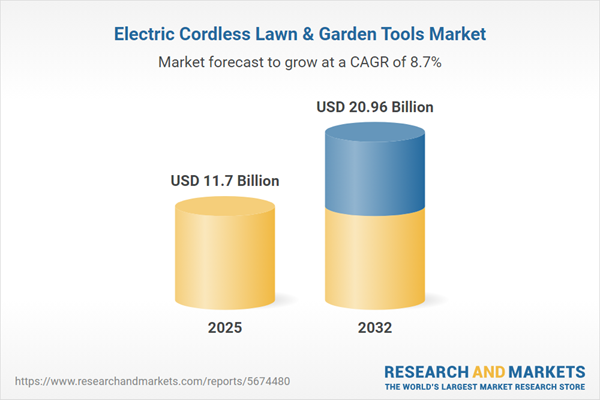Speak directly to the analyst to clarify any post sales queries you may have.
The electric cordless lawn and garden tools market is rapidly transforming landscaping and grounds maintenance for both residential and commercial users, driven by sustainability and evolving technology. Industry leaders recognize the sector's role in shaping modern outdoor practices and are realigning strategies to seize growth opportunities in a dynamic regulatory and consumer environment.
Market Snapshot: Electric Cordless Lawn and Garden Tools
The global electric cordless lawn and garden tools market grew from USD 10.78 billion in 2024 to USD 11.70 billion in 2025. With a compound annual growth rate (CAGR) of 8.66%, the market is projected to reach USD 20.96 billion by 2032. Heightened demand for battery-powered alternatives—fueled by environmental mandates, noise abatement laws, and user preference for convenience—continues to reshape industry priorities and competitive dynamics.
Scope & Segmentation
- Product Types: Chainsaws, edgers, grass trimmers, hedge trimmers, riding lawn mowers, walk-behind lawn mowers, zero turn lawn mowers, leaf blowers, leaf vacuums mulchers, and tillers cultivators.
- End Users: Residential consumers, commercial landscaping firms, and municipal groundskeepers.
- Battery Types: Lithium-ion and nickel-cadmium options, catering to varying price points and performance requirements.
- Distribution Channels: Direct sales, offline specialty stores, and online retailers.
- Motor Types: Brushed and brushless technologies for reliability and efficiency.
- Battery Voltage: Categories include less than 20V, 20-30V, 30-40V, and above 40V platforms to match diverse power demands.
- Battery Capacity: Less than 2Ah, 2-3Ah, 3-5Ah, and above 5Ah, each affecting tool weight and runtime.
- Regions Analyzed: North America (United States, Canada, Mexico), Latin America (Brazil, Argentina, Chile, Colombia, Peru), Europe (United Kingdom, Germany, France, Russia, Italy, Spain, Netherlands, Sweden, Poland, Switzerland), Middle East (United Arab Emirates, Saudi Arabia, Qatar, Turkey, Israel), Africa (South Africa, Nigeria, Egypt, Kenya), and Asia-Pacific (China, India, Japan, Australia, South Korea, Indonesia, Thailand, Malaysia, Singapore, Taiwan).
- Companies Profiled: Leading brands such as Andreas Stihl AG & Co. KG, Husqvarna AB, Stanley Black & Decker, Makita Corporation, Robert Bosch GmbH, The Toro Company, Techtronic Industries, Einhell Germany AG, Positec Tool Corporation, and Briggs & Stratton LLC.
Key Takeaways for Decision-Makers
- Ongoing advancements in battery chemistry and motor design support sustained growth by delivering tools that compete with or exceed traditional power equipment in both output and efficiency.
- Integration of digital features—such as smart battery monitoring and tool connectivity—continues to influence consumer purchasing decisions and enable new recurring revenue models for manufacturers.
- Commercial landscaping organizations are prioritizing electric fleet upgrades to comply with stricter environmental and noise regulations, particularly in urban and suburban markets.
- Varied regional regulations, climate challenges, and local consumer expectations require tailored product portfolios and adaptive distribution strategies for successful market penetration.
- Leading manufacturers pursue standardized battery ecosystems and modular tool platforms to build brand loyalty while addressing the specific needs of both entry-level and professional users.
- Aftermarket services—including extended warranties and fleet management support—play a critical role in influencing customer retention and long-term profitability.
Tariff Impact on Supply Chains and Competitiveness
Recent United States tariffs on imported components have increased costs for batteries and electronic parts, leading to supply chain realignments. Manufacturers are investing in nearshore and domestic production, forming strategic partnerships with local suppliers and adopting automation. This shift influences pricing, product offerings, and margin strategies across the sector, prompting new approaches to stay competitive amid evolving trade policies.
Methodology & Data Sources
This analysis employs a blend of primary interviews with industry executives, secondary research from regulatory filings, and quantitative assessments from proprietary market databases. Data triangulation and expert panel reviews ensure accurate, actionable insights for planning and investment decisions.
Why This Report Matters
- Provides in-depth intelligence on technology trends, segmentation, and evolving regulatory landscapes in the electric cordless lawn and garden tools market.
- Enables decision-makers to benchmark against key players and develop resilient go-to-market and supply chain strategies in response to trade and environmental pressures.
Conclusion
Senior leaders seeking to navigate market complexity and capitalize on the shift to electric cordless solutions will benefit from actionable insights in this report. Strategic adaptation to regulatory, technological, and consumer trends is essential for long-term success in this dynamic sector.
Additional Product Information:
- Purchase of this report includes 1 year online access with quarterly updates.
- This report can be updated on request. Please contact our Customer Experience team using the Ask a Question widget on our website.
Table of Contents
3. Executive Summary
4. Market Overview
7. Cumulative Impact of Artificial Intelligence 2025
Table Information
| Report Attribute | Details |
|---|---|
| No. of Pages | 180 |
| Published | November 2025 |
| Forecast Period | 2025 - 2032 |
| Estimated Market Value ( USD | $ 11.7 Billion |
| Forecasted Market Value ( USD | $ 20.96 Billion |
| Compound Annual Growth Rate | 8.6% |
| Regions Covered | Global |
| No. of Companies Mentioned | 11 |









